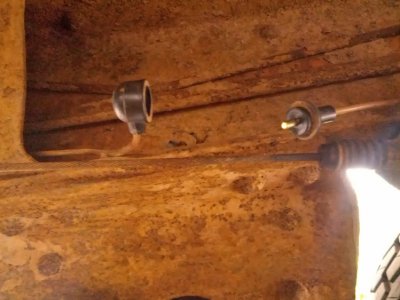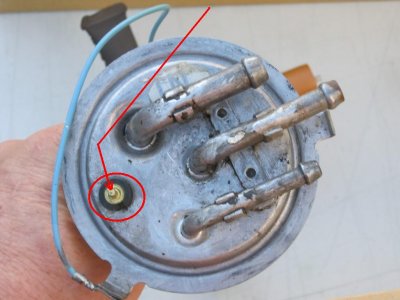so I found that's its pegged full, but I have not found a broken pink wire, found that when I ground the pink extension at the plug it goes towards empty but when it all plugged correct it goes all the way to the right is it possible one of the coils are bad ? on the gauge. oh and thanks for the help.
No problem with helping, Deano but I am having some trouble following the results of the diagnostic -sorry, we'll get it.
1. Initially you posted this:
"but I'm not where to start with my gas gauge I have movement (not
starting from e)".
I understood that to mean: the gauge wouldn't move off
the empty end of the scale. Not correct, I guess - because now I see this:
2.
so I found that's its pegged full, Do you mean that it is always
pegged full - like stuck? Or do you mean only when the ignition switch is
moved to RUN, then does the needle swing over to F?
3.
but I have not found a broken pink wire,
It is not always easy to locate a damaged lead in that rear lighting/fuel
tank control harness. Very often the damage is internal (under the
insulation)and cannot be identified by visual inspection. That why we've
started figuring this out using the methods described. If you rather, we
can switch to using a Fluke meter -I just wasn't sure if you had one.
But if I am reading things right, that's (a broken PNK-30 lead) not the
problem anyway. If the gauge moves decisively toward the lower end of
the scale when the splice end of
forward section of the PINK-30 circuit is
disco'd & grounded...that would indicate the conductors are intact. I think we can forget that - for now anyway.
4.
found that when I ground the pink extension at the plug it goes towards
empty but when it all plugged correct it goes all the way to the right is it
possible one of the coils are bad ?
The test procedure was this: disconnect the two sections of PNK-30 at the
splice and ground the back end of the long wire - the one that runs from
the dash gauge. I apologize if I didn't explain it well, it really should have
only taken 5-10 minutes
It was
not to ground the short extension that runs across the
crossmember to the tank selector valve.
What we were trying to determine was whether the components in the front
section of the circuit were operating properly (i.e. power to the gauge, a
functional gauge & and continuity in the long pink wire that connects to the
extension). If they were, we'd be almost done.
2. I'm completely lost on this one - I just don't get what you are trying to
say:
but when it all plugged correct it goes all the way to the right
I'll take a stab at it though. I
think you are saying that: the power to the gauge, the gauge itself and the PNK-30 circuit all seemed to behave as designed during the tests, but when everything was placed back in actual operation...the gauge was indicating (incorrectly I hope) that the tank was full.
It brings me to what - I asked last night:
The gas gauge will not give an accurate reading on either tank - is that correct?
Also, please tell me that you know for a fact - at least approximately how much gas is in each tank.
Couple more:
How long you have had this truck?
Did the gas gauge ever work right?
Have you recently done any modifications or repairs behind the cab - particularly to the exhaust system or frame? If so what was done?
Is this problem only about tank level readings - or is the Pollak valve unable to switch from tank to tank also.
Here is the next step:
The PNK-30 circuit is completely independent of the tank transfer valve when the splice is disconnected. The gas gauge will read the level in whichever tank's sender the little brass button is pushed onto.
The LH tank is referred to as the production tank. The RH one is the auxiliary tank. Break the splice again and this time just pull the sensing lead off the production tank (only because it is right there by the splice) - that lead should be pink with a white tracer. The other one (blue or black) is the ground wire out off the sender to the frame. Check that there is continuity from the sender end of the ground wire to the frame, if there is - good. Then push the ass end of the long PNK-30 lead directly onto the little brass pin on the sender of the production tank. Sound the tank to get a basic idea of the level in it and fire the circuit up.
Get back to us with the results and we'll put fork in this ******.
You must be registered for see images attach
You must be registered for see images attach
You must be registered for see images attach



